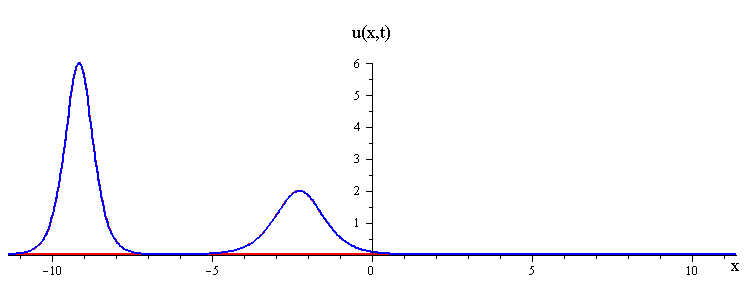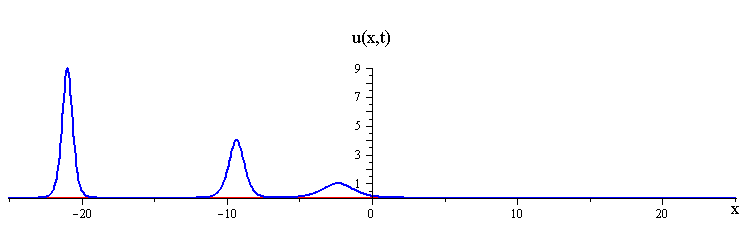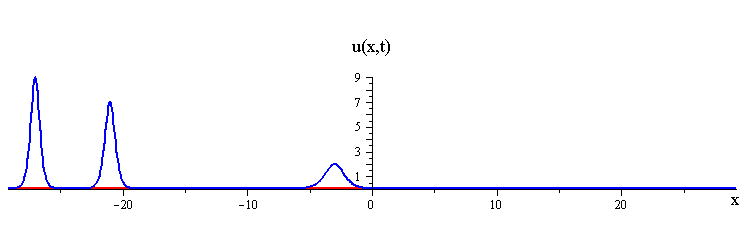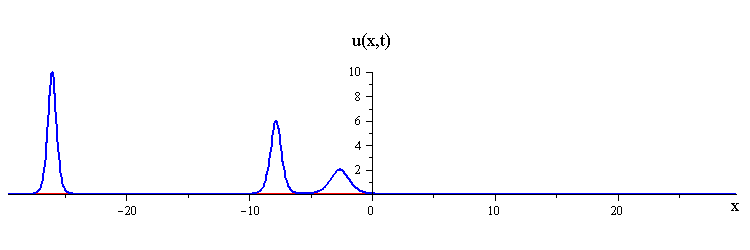KdV Solitons
KdV Equation ut + αuux + βuxxx = 0
The coefficients α, β in the general form of the KdV equation can be freely changed through scaling/reflection transformations on the variables u, x, t. A conventional choice is α = 6, β = 1, which eliminates awkward numerical factors in the expressions for soliton solutions.1-Soliton Solution
The KdV 1-soliton solution iswhere c > 0 is the wave speed and ξ = x−ct is a moving coordinate.

2-Soliton Solution
The KdV 2-soliton solution is+ (√c1 + √c2) cosh((√c1 ξ1 − √c2 ξ2)/2) )2
where c1 > c2 > 0 are the wave speeds and ξ1 = x−c1t, ξ2 = x−c2t are moving coordinates.
As t → ±∞, the 2-soliton solution has the asymptotic form of a linear superposition of travelling waves (i.e. single solitons) with speeds c1 and c2. The two waves wave collide such that the moment of greatest nonlinear interaction occurs at t = 0 when the profile is symmetric is symmetric around x = 0. The shape of this profile u(x,0)= u(−x,0) is characterized by its convexity u(x,0)xx|x=0 which is positive or negative depending on whether the speed ratio is greater or less than a critical value c1 / c2 = 3 (for which the convexity vanishes).
For speed ratios c1 / c2 > 3, the profile has a single peak at x = 0 and an exponentially diminishing tail as x → ±∞. In this case the waves interact nonlinearly by first merging at x = t = 0 and then splitting apart.

ratio of fast to slow wave speeds is > 3
(Click here to see the space time portrait)
For speed ratios c1 / c2 < 3, the profile has a double peak around x = 0 and an exponentially diminishing tail as x → ±∞. In this case the waves interact nonlinearly by first bouncing and then exchanging shapes and speeds at x = t = 0.

ratio of fast to slow wave speeds is < 3
(Click here to see the space time portrait)
Overlay of 1-soliton solutions and corresponding 2-soliton solution

ratio of fast to slow wave speeds is > 3

ratio of fast to slow wave speeds is < 3
and the slower wave gets shifted backward by
where k1 = √c1 > k2 = √c2 > 0.
Multi-soliton Collisions
Multi-soliton solutions have the same interaction features displayed by the 2-soliton solution.3-Soliton Simultaneous Collision Solution

(Click here to see the space time portrait)
All three waves collide at x = 0, t = 0.
3-Soliton Pair-wise Collision Solution

(Click here to see the space time portrait)
The two fastest waves interact first and then overtake the slowest wave
3-Soliton Pair-wise Collision Solution

(Click here to see the space time portrait)
The two slowest waves interact and eventually both are overtaken by the fastest wave.